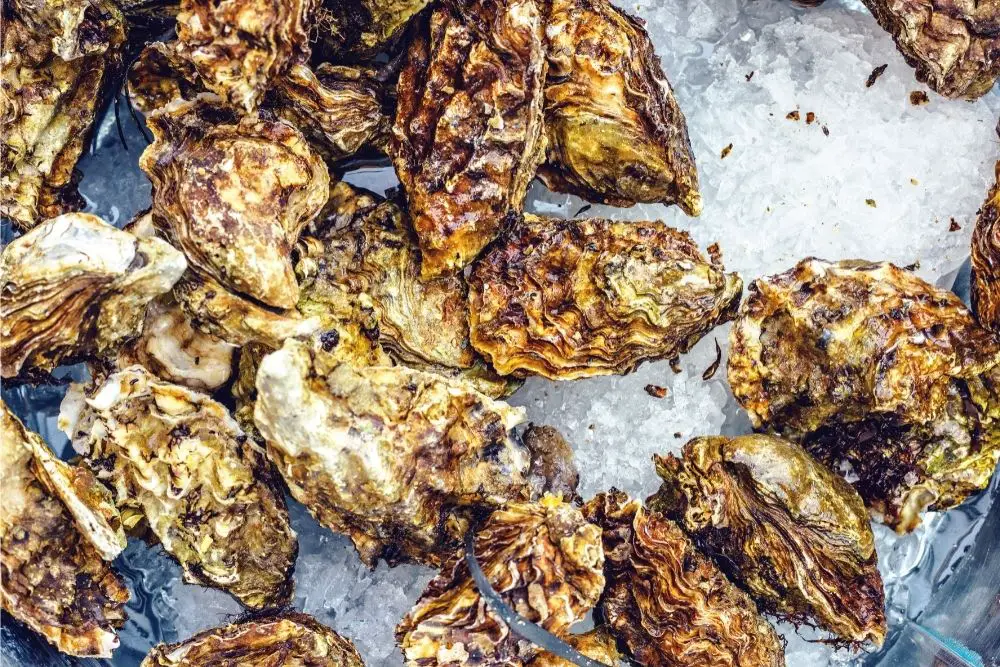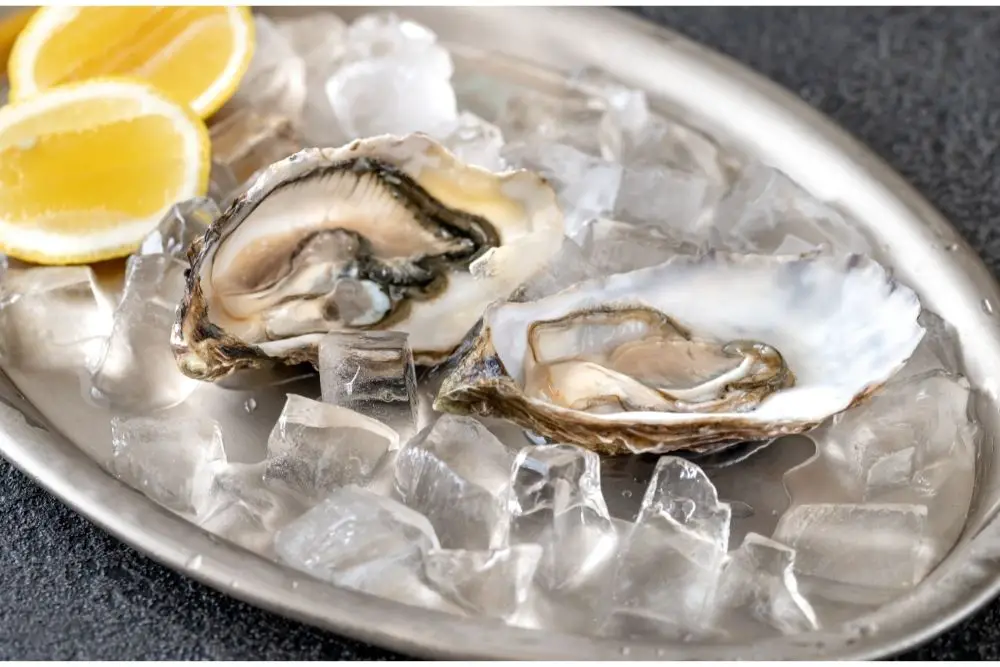Disclosure: Thank you for reading our articles! Some links may be affiliate links. We may get paid if you buy something or take an action after clicking one of these links. Additionally, as an Amazon Associate, I earn from qualifying purchases.
Oysters are one of the sea’s many treasures. Not just because you’ll sometimes find a smooth, round, iridescent pearl hidden inside the tough, outer shell that must be split open in order to discover such spoils, but also because oysters taste incredible when prepared well.
They do, however, need to be stored in a particular way in order for them to remain fresh and delicious, so we’re here to tell you exactly how you should store your oysters and how long they will keep for, whether you bought them live, raw, shucked, or still in their shells.

How Long Can I Store Live Oysters?
You can buy canned oysters which will typically last longer, but fresh oysters taste better.
Provided that they’re stored correctly, live oysters can survive out of the water but still in their shell for about 4 to 5 days.
This is because oysters don’t breathe after leaving the water, which is also why you should avoid submerging them in water again once they’re out of it.
On the fifth day, if you haven’t already eaten them by now (and if you haven’t… what are you waiting for?!), you can shuck the oysters and store them in the fridge where they will keep for an additional 2 to 3 days in a bowl or a container that is covered with a damp towel.
As will all types of fresh food that have a short shelf life, the sooner you consume the live oysters you bought at the market, the fresher they will be and the better they will taste.
If you’re not planning on using your oysters for a couple of days, it’s often a good idea to wait until closer to the day you’ll be having them for dinner to pick them up at the market or store.
How to Store Live Oysters Overnight
Shellfish is always at its best when it’s freshest, so it’s best to consume these types of seafood immediately when you can.
It’s not always possible, however, and buying the necessary ingredients for tomorrow night’s meal is sometimes more convenient. Luckily, you can store live oysters overnight so they’ll still be safe and tasty to eat for dinner tomorrow.
As we mentioned above, live oysters can be stored in the fridge, and it’s fine to leave them in here overnight where they can remain cool.
To lengthen their shelf life, you can lay the oysters flat-side up (large shell-side down) and cover them with a damp cloth in a container.
Oysters do best in cold conditions, so make sure that their environment is kept cool without allowing them to reach freezing temperatures.
Storing them in the freezer is out of the question for this reason, as if they freeze completely they will no longer be okay to eat.
How to Store Fresh Oysters
Storing fresh oysters starts with buying the freshest oysters in the first instance, so make sure to look out for any signs that your selection of seafood is past its best.
A great place to look is The Crab Place which has a selection of fresh, high-quality oysters.
Look out for any signs that the oysters you’re buying aren’t fresh. Dead oysters will typically have looser shells or they could be cracked and broken in places.
These should be avoided in favor of oysters that feel heavier and full of water, so discard any that you find.
You don’t need to shuck or wash your oysters until you’re planning on eating them, as they usually taste best when this is done immediately beforehand.
Plus, keeping the shells on means they’re easier to store and will help to prevent them from going bad too soon.
When you get home from the market, the best way to store your fresh oysters is to keep them inside the bag or packaging they came in.
Place this inside a bowl with a damp cloth covering the top, or you could store them on a bed of fresh ice for a few hours, provided you keep an eye on things to make sure that the ice doesn’t melt and leave the oysters in water.

How to Store Oysters in a Shell
Storing your oysters cupped or curved shell-side down is another way you can help to preserve their natural juices for a more flavorful and succulent seafood feast.
This moisture allows them to breathe, meaning they will stay fresher for a longer period of time.
When you’re storing oysters, particularly if they’re being stored with their shells still on, it’s important to keep them away from any type of moving air, such as a cooling fan, as this will cause the oysters to dry out faster which results in them being less tender and tasty to eat.
You can store shelled oysters on a bed of ice like you often see fishmongers do at the seafood market in order to display their catches for the public to peruse and purchase.
Never allow them to become submerged in freshwater for any period of time, however, and make sure to change the ice regularly every couple of hours to prevent excessive pooling water.
How to Store Oysters in the Fridge
We’ve mentioned a couple of times that you can store oysters in the fridge where they’re kept in containers, but it’s important to point out that you should never store oysters in a sealed or airtight container.
This can cut off the oysters’ oxygen supply which can cause them to suffocate, meaning they will go bad much sooner and won’t be safe to consume.
Dampening the cloth or towel you’re using to cover the bowl or container where your oysters are being stored inside the fridge means they won’t dry out and will help to keep them cool.
You should also pay attention to where you place your oysters within your fridge.
Avoid storing them underneath other types of raw meat where the potential of dripping meat juice could lead to cross-contamination of your food which would make it unsafe to consume.
The ideal fridge temperature is between 4 and 8 degrees celsius, as anything below 1-degree Celsius or less than freezing temperature, which is 0 degrees celsius, can kill the oysters meaning they’re unsafe to eat.
To get an accurate temperature reading in your refrigerator, you can keep a temperature thermometer inside and check its readings.
How to Store Shucked Oysters
It’s often recommended that you should save shucking your oysters until right before you’re planning on eating them, as this is the best way to enjoy their freshness and flavor.
Not everyone has the time to spend shucking oysters right before dinner, however, and so it can be helpful to know how to store shucked oysters.
This will allow you to prepare them ahead of time so that they’re ready to go straight out of the fridge come the evening.
So, how do you store shucked oysters? After you’ve shucked them, you can store de-shelled oysters in the liquid they were steeped in whilst they were still in their shells.
Keeping them in the fridge in their own liquor means they will keep for up to 2 days, but try to consume them as quickly as possible after shucking your oysters for the best results.
An alternative method for storing shucked oysters is to freeze them, although this should never be done with oysters that are still in their shells.
This method of storage will keep the de-shelled oysters fresh for up to 3 months, although the closer you get to the 3-month mark, the more the oysters will have lost some of their freshness and flavor.
What is the Best Way to Shuck Oysters?
When you come to prepare the oysters you’ve freshly bought or successfully stored using one of the methods we’ve explained in this article, you’ll need to shuck them to remove the hard, outer shell that protects them (and potentially their pearl) when they’re in the water.
The first thing you should do is run the oysters under cold water and prize apart their shells slightly.
Next, take a small, sharp knife and run its pointed end around the flat-sided edge of the oyster to carefully pop the shell off.
It can be a good idea to wear gloves whilst you’re doing this part of shucking the oysters, as any slips could cause a nasty nick in your skin.
There are some great oyster knife shucking sets available, like this option which comes with an included protection guard to prevent accidents with the knife.
Once the shell has been split open, use a knife to carefully separate the oyster from its shell bed.
Do one last visual check of the oyster so you know it’s safe to eat, which includes looking at the shell to make sure there are no signs of damage or breaking.
If there is any discoloration around the oyster or if it’s emitting an unpleasant smell, do not eat it.
You should throw away any oysters that have turned a cloudy, grey-ish color or any shades of brown, black, or pink, as this is an indication that they have gone bad.


